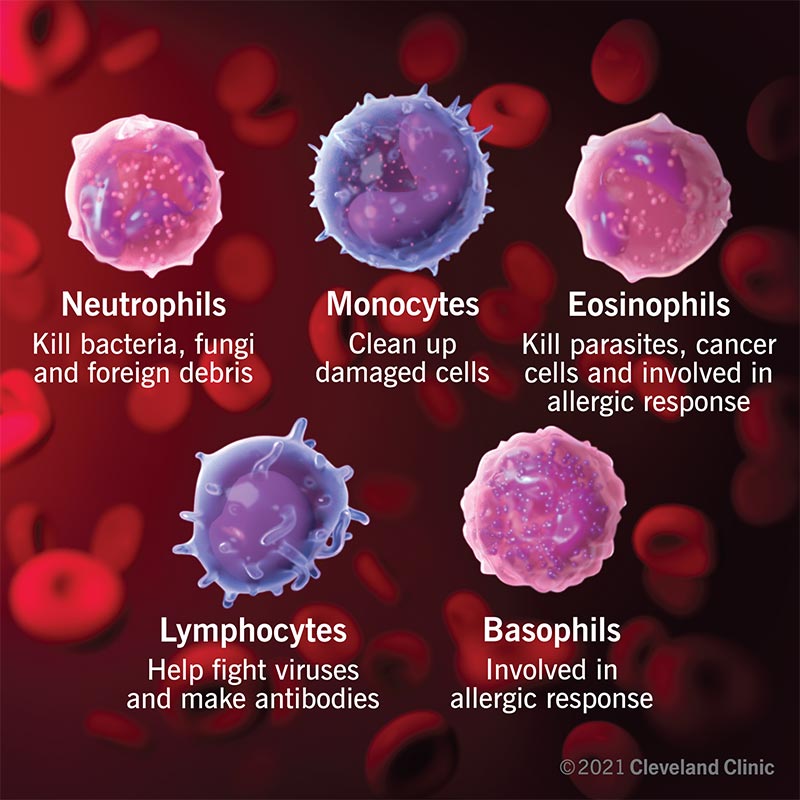White blood cells are a part of your immune system that protects your body from infection. These cells circulate through your bloodstream and tissues to respond to injury or illness by attacking any unknown organisms that enter your body.
Advertisement
Cleveland Clinic is a non-profit academic medical center. Advertising on our site helps support our mission. We do not endorse non-Cleveland Clinic products or services. Policy
White blood cells, also known as leukocytes, are responsible for protecting your body from infection. As part of your immune system, white blood cells circulate in your blood and respond to injury or illness.
Advertisement
Cleveland Clinic is a non-profit academic medical center. Advertising on our site helps support our mission. We do not endorse non-Cleveland Clinic products or services. Policy
White blood cells protect your body against infection. As your white blood cells travel through your bloodstream and tissues, they locate the site of an infection and act as an army general to notify other white blood cells of their location to help defend your body from an attack of an unknown organism. Once your white blood cell army arrives, they fight the invader by producing antibody proteins to attach to the organism and destroy it.

Your white blood cells are in your bloodstream and travel through blood vessel walls and tissues to locate the site of an infection.
Contrary to their name, white blood cells are colorless but can appear as a very light purple to pink color when examined under a microscope and colored with dye. These extremely tiny cells have a round shape with a distinct center membrane (nucleus).
You can only see white blood cells under a microscope, as they are extremely small.
White blood cells account for 1% of your blood. There are more red blood cells in your body than white blood cells.
White blood cell formation occurs in the soft tissue inside of your bones (bone marrow). Two types of white blood cells (lymphocytes) grow in the thymus gland (T cells) and lymph nodes and spleen (B cells).
Advertisement
White blood cells originate from cells that morph into other cells in the body (stem cell) within the soft tissue of your bones (bone marrow).
There are five types of white blood cells:
If you have a low white blood cell count, you are likely to get infections (leukopenia). If your white blood cell count is too high (leukocytosis), you may have an infection or an underlying medical condition like leukemia, lymphoma or an immune disorder.
Symptoms of white blood cell conditions, where you may have a count that is too high or too low, include:
It is normal for you to produce nearly 100 billion white blood cells each day. After completing a blood draw, a test counts your white blood cells, which equals number of cells per microliter of blood. The normal white blood cell count ranges between 4,000 and 11,000 cells per microliter.
A complete blood count (CBC) test identifies information about the cells in your blood. A lab completes this test after a medical professional draws your blood and examines your white and red blood cell count.
White blood cells scan is a test to detect infection or abscesses in your body’s soft tissues. This test involves withdrawing your blood, separating the white blood cells from the sample, tagging them with a radioactive isotope, returning those white blood cells back into your body, then an imaging test will identify areas that show infection or abscess on your body.
Causes of low white blood cell count include:
A blood test with fewer than 4,000 cells per microliter of blood diagnoses low white blood cells.
Causes of high white blood cell count include:
Advertisement
A blood test with more than 11,000 cells per microliter of blood diagnoses high white blood cells.
Treatment for white blood cell disorders vary based on the diagnosis and severity of the condition. Treatment ranges from:
You can take care of your white blood cells by:
White blood cells serve as your first line of defense against injury or illness. Keep your white blood cells healthy by taking vitamins to boost your immune system and practicing good hygiene to prevent infection. If you experience any symptoms like fever and chills, frequent infection, persistent cough or difficulty breathing, contact your healthcare provider to test if your white blood cell count is abnormal.
Advertisement
Cleveland Clinic’s primary care providers offer lifelong medical care. From sinus infections and high blood pressure to preventive screening, we’re here for you.

Last reviewed on 07/23/2021.
Learn more about the Health Library and our editorial process.